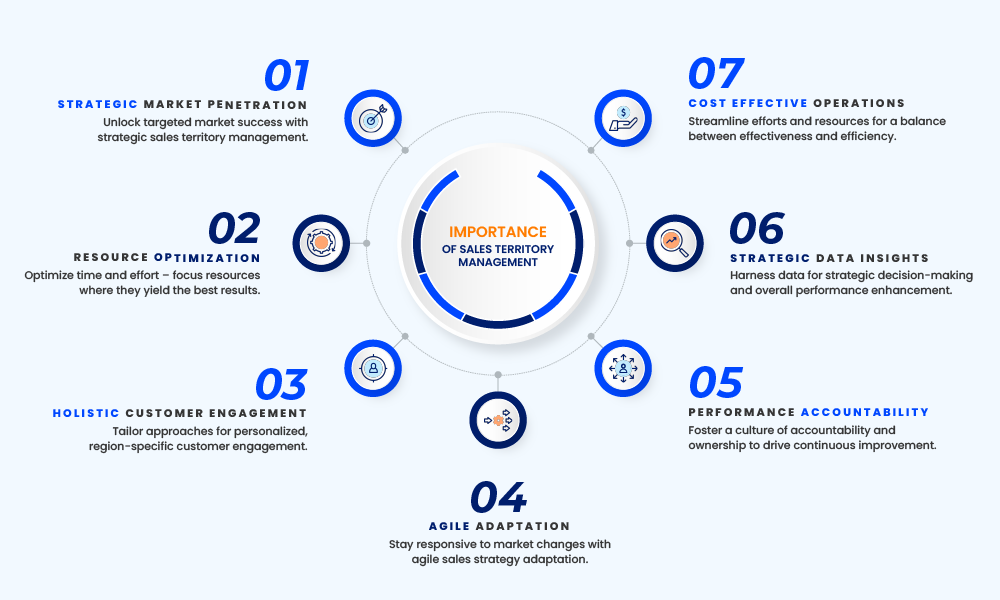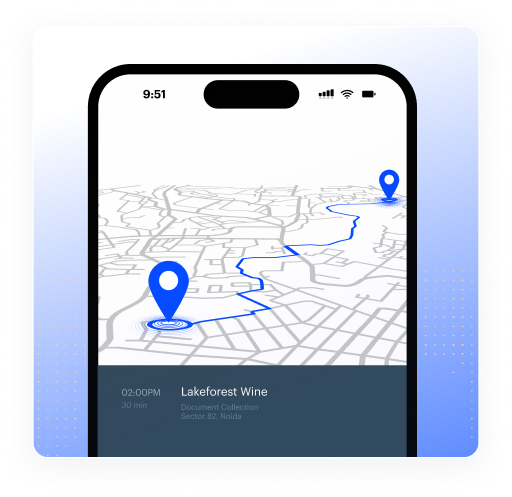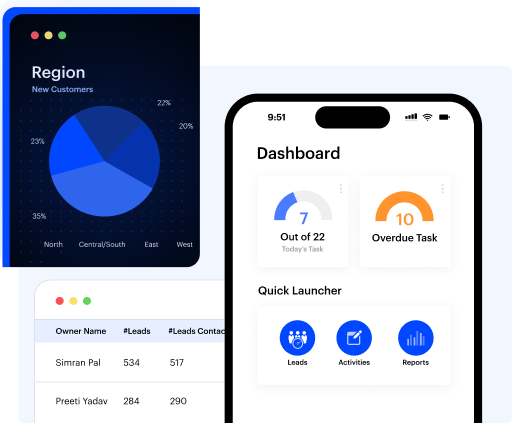‘When in Rome, do as the Romans do’ is more than just good travel etiquette.
It can be your most effective strategy to unlock the true revenue potential of all your sales territories.
How?
In the dynamic field of sales, the effective management of territories is a linchpin for success and this linchpin lies in your ability to customize and adapt to each unique territory.
Sales Territory Management involves dividing the market into specific areas, assigning each to a sales rep, and tailoring strategies for maximum impact in those regions.
The goal is to boost efficiency, prevent overlap, and optimize sales efforts in a targeted way.
In this blog, you will learn why sales territory management is worth your time, the steps to set up a winning sales territory plan, and the best practices that promise to yield the highest benefits in every territory.
What is Sales Territory Management?
Sales territory management is the strategic process of dividing a market into geographic areas to optimize sales efforts.
It involves planning, organizing, and directing sales activities within these designated territories.
The primary goal is to maximize efficiency by tailoring sales strategies to the unique needs and characteristics of each region.
This essentially enables you to customize your approach to boost sales where it matters most, create a real impact on the ground and build stronger connections with customers in diverse market landscapes.
The Importance of Sales Territory Management
Sales Territory Management is indispensable for business success, particularly for managers and sales representatives, as it operates at the core of strategic sales operations.

Here’s what you stand to gain from effective sales territory management:
- Strategic market penetration: A competent sales territory plan allows businesses to strategically penetrate diverse markets by tailoring sales strategies to the unique characteristics of each territory.
Example: Apple strategically positions its flagship stores in upscale urban centers with a high concentration of tech enthusiasts. The Apple Store on Fifth Avenue in New York City, for instance, caters to the luxury tech market, providing a hands-on experience with the latest devices in a prime location known for high-end shopping.
- Resource optimization: Efficient territory management involves strategic allocation of sales personnel, marketing efforts, and other resources based on the potential of each territory.
By identifying high-potential areas and allocating resources accordingly, a company can maximize its return on investment and reduce unnecessary costs.
Example: Tesla optimizes resources by assigning experienced electric vehicle sales specialists to regions where environmental consciousness is a priority. In California’s Silicon Valley, Tesla’s sales teams leverage their expertise to appeal to the tech-savvy population, contributing to the brand’s dominance in the electric vehicle market.
- Holistic customer engagement: Sales teams are able to develop a deeper understanding of the unique needs and preferences of customers within specific territories.
By tailoring sales and marketing strategies to the characteristics of each territory, businesses can enhance customer satisfaction and boost customer retention.
Example: Louis Vuitton‘s flagship store on Champs-Élysées in Paris is a prime example of holistic customer engagement. Sales associates, trained in the history of the brand and the art of luxury, go beyond transactions. They curate personalized shopping experiences, host exclusive events, and establish enduring relationships with high-end clientele.
- Agile adaptation: Your territory plan provides a reliable framework for agile adaptation, enabling quick responses to the changes in customer behavior, market trends, and competitive landscapes.
Real-time field feedback provides a data-driven foundation for making informed decisions, ensuring the adaptability and relevance of your sales approaches.
Example: Recognizing the demand for regional content, Netflix deftly adjusted its sales approach in territories like India.
Sales teams focused on forging partnerships and acquiring rights for popular local films and series, ensuring that the platform’s content resonated with the nuanced preferences of Indian audiences.
This adaptation not only boosted subscriber numbers but also solidified Netflix’s position as a go-to streaming service for diverse and culturally rich content.
- Performance accountability: Assigned territories instill a sense of ownership and accountability for sales reps, fostering increased motivation and a proactive approach to achieving goals.
Additionally, the resulting transparency helps in recognizing top-performing individuals, identifying areas for improvement, and fostering a culture of continuous learning and development within the organization.
Example: Pfizer‘s sales representatives in the Northeastern United States not only track pharmaceutical sales but actively engage with healthcare providers to monitor patient outcomes.
This accountability ensures that Pfizer’s medications not only reach the market but contribute positively to patient health.
- Strategic insights through data: Effective territory plans yield a large volume of well classified data. Relying on data analysis, this approach goes beyond routine reporting to uncover trends, identify growth opportunities, and refine strategies based on real-time field feedback.
Example: Amazon leverages sales territory management to analyze customer data in urban versus suburban areas.
This data-driven approach influences Amazon’s inventory management, allowing the company to stock products that align with the distinct preferences of urban and suburban customers.
- Cost-effective operations: Beyond reducing travel costs, efficient territory management involves streamlining processes, minimizing redundancies, and optimizing workflows for overall operational efficiency.
Example: FedEx optimizes delivery routes in densely populated cities like Tokyo, where package delivery density is high.
By strategically planning delivery routes, FedEx minimizes fuel consumption and delivery times, contributing to efficient and cost-effective operations in metropolitan areas.
Now that you’re aware of the significance of sales territory management, the next step is to set up your own sales territory plan.
Steps To Create a Winning Sales Territory Plan
Create your own territory plan in 12 simple steps with insights from the strategies of industry giants:
1. Understand your market: Conduct thorough research to understand your target market, including demographics, industry trends, and competition.

In 2021, Adidas conducted market analysis revealing a rising interest in sustainable fashion. They responded by launching the “Futurecraft.Footprint” sneaker, showcasing their commitment to eco-friendly products and reducing carbon emissions.
2. Set clear objectives: Define specific, measurable, and achievable sales goals for your territory. These could include revenue targets, market share growth, or customer acquisition metrics.

Walmart’s clear goal to expand its same-day delivery service was realized by investing in technology and partnerships. They achieved a 60% increase in same-day delivery orders, meeting customer demands for faster and convenient shopping.
3. Segment your territory: Divide your territory into manageable segments based on factors like geography, industry, or customer size. This helps tailor your approach to specific needs.

Starbucks, in 2022, introduced location-specific coffee blends in response to regional preferences. The “City Mugs” campaign highlighted unique coffee blends exclusive to certain cities, creating a buzz and increasing sales in those areas.
4. Customer profiling: Develop detailed profiles of your target customers within each segment. Understand their pain points, preferences, and buying behaviors to tailor your sales strategy.

Recognizing the rise in skincare awareness, L’oreal, launched the “Age Perfect Radiant Serum Foundation”, targeting the 50+ age group. The product’s success was attributed to a deep understanding of the aging demographic’s skincare needs.
5. Prioritize prospects: Identify high-potential accounts and prioritize them based on factors like revenue potential, strategic fit, and ease of conversion.

Tesla prioritized the Chinese market in early 2022 by opening a Gigafactory in Shanghai. This strategic move not only reduced manufacturing costs but also allowed Tesla to respond quickly to the growing demand for electric vehicles in China.
6. Resource allocation: Allocate resources effectively, considering factors like sales team size, marketing budget, and support staff. Ensure that your resources align with the potential of each segment.

Best Buy optimizes resource allocation using customer analytics, analyzing in-store and online data to pinpoint high-potential territories and make adjustments accordingly.
Adjustments include increased inventory, elevated marketing investments, and assigning experienced staff to capitalize on demand, leading to heightened sales and customer satisfaction.
7. Sales territory mapping: Create a visual map of your territory, highlighting key accounts, competitors, and strategic locations. This helps in optimizing travel and resource allocation.

Johnson & Johnson uses GIS technology to map sales territories for its medical device division, enabling the medical device sales team to optimize their routes, prioritize key accounts, and tailor product offerings, leading to improved customer relationships, increased market share, and more effective territory coverage.
8. Develop specialized sales strategies: Tailor your sales approach for each segment, considering the unique needs and preferences of your target customers. Align your strategies with overall company goals.

Samsung, in 2022, revamped its sales strategy by offering extended warranties and personalized support for premium smartphones. This customer-centric approach aimed to increase brand loyalty and satisfaction.
9. Sales training and evelopment: Ensure your sales team is equipped with the right skills and knowledge to effectively engage with prospects. Provide continuous training to adapt to market changes.

General Electric invested in virtual reality (VR) training for its sales team and this immersive approach enhanced their understanding of complex industrial products, resulting in more confident and informed client interactions.
10. Monitoring and evaluation: Implement a system to monitor and evaluate the performance of your sales territory plan. Regularly review key metrics and adjust strategies as needed to stay agile in the market.
Google refined its advertising algorithms in 2022 to prioritize user privacy. The introduction of the “Privacy Sandbox” aimed to provide advertisers with valuable insights while respecting user data protection, ensuring compliance with evolving regulations.
11. Feedback loop: Establish a feedback loop with your sales team to gather insights from the field. This information is valuable for refining strategies and addressing challenges in real-time.

Zoom employs a robust feedback loop to drive innovation in its video conferencing platform. This loop, facilitated through a dedicated form on their website, ensures continuous improvement, keeping Zoom agile, user-focused, and responsive.
12. Adaptability: Markets evolve, so be ready to adapt your plan. Stay informed about industry trends, customer feedback, and competitive actions, and adjust your strategies accordingly.

In 2021, Netflix adapted its content strategy by investing heavily in interactive storytelling. The success of interactive films like “Bandersnatch” demonstrated Netflix’s agility in responding to changing viewer preferences for immersive content experiences.
Remember, a winning sales territory plan is a dynamic document that requires continuous refinement based on market changes and feedback from the field.
5 Strategies to Nail Sales Territory Management
In practical execution, managing sales territories is a tall order because it entails constant analysis of the ever-changing market and time-sensitive strategic realignment.
Here are 5 strategies designed to make this a cakewalk for you:
1. Utilizing software and tools:
Leverage advanced software and tools to enhance the efficiency of your sales territory management.
CRM systems, in particular, can be instrumental in organizing and analyzing data.

LeadSquared’s Mobile CRM helps you set up sales territories and accordingly assign leads to your field reps. Geo-fence their tasks and minimize fake location check-ins and falsified meeting logs.
Send automated beat plans to your sales reps that cover everything from number of meetings scheduled and goals for the day to best travel route. Boost productivity and minimize distractions.

Conduct reliable field sales surveys by creating standard survey forms and assigning them for each location to your reps. Geofence reps and auto-populate location details using the geotagging feature.

Leverage detailed reports to assess which lead source, geography, demography, product, and sales rep is bringing in the most revenue.
This helps you identify trends in different territories and guides your strategy revisions with data backed inferences.
2. Implementing predictive analytics for upselling
Implement predictive analytics to identify upselling opportunities within existing customer accounts in each territory. Analyze past purchasing patterns, customer behavior, and market trends to anticipate additional product or service needs.
Increase revenue by strategically presenting relevant upselling opportunities
to customers, demonstrating a proactive understanding of their evolving needs.
For example: Netflix employs predictive analytics to analyze viewing habits within specific regions. By understanding viewer preferences, Netflix suggests personalized content recommendations, contributing to increased subscription retention and additional revenue.
3. Leveraging localized influencer partnerships
Forge partnerships with local influencers or thought leaders in key territories. Leverage their influence to promote your products or services within the community, tapping into their established trust and credibility.
Enhance brand visibility, build local trust, and generate authentic interest in your offerings, leveraging the influencers’ connection with the target audience.
For example, Starbucks collaborates with local influencers in different cities to promote region-specific products and events. These influencers share their Starbucks experiences within their local communities, contributing to increased foot traffic and sales in those specific territories.
4. Strategic account planning
Develop detailed account plans for key customers within each territory.
Tailor sales strategies for long-term relationships by understanding customers’ business goals, challenges, and buying cycles.
A prime example of effective strategic account planning is Microsoft’s engagement with major enterprise clients such as IKEA and PayPal.
Microsoft’s account managers work closely with each client, conducting in-depth analyses of their business objectives and challenges.
5. Tailoring approach to territory-specific customer behavior
Customer behavior is bound to vary across regions. Ensuring that you tailor your sales approach to their preferences will optimize your resource allocation.
Lead source, lead engagement and lead score are a few pointers that can help you customize your approach.
Additionally, your reports will give you a good idea about what line of action is effective in which territory.
Consider the following example from our own records:
“While targeting prospects in the GCC, sending emails, SMS and other digital engagement campaigns will help with the discovery call but the deal will not advance towards closure without an in-person meeting.”
– Atharva Dubey, LeadSquared,Cluster Head-Sales, Middle East
Atharva’s findings underscored the significance of in-person meetings for deal closure in the GCC (Gulf Cooperation Council).
In conclusion, mastering sales territory management is the key to unlocking untapped potential in diverse markets.
By implementing strategic segmentation, personalized approaches, and continuous refinement, businesses can elevate their sales effectiveness. Make quick work of this and maximize your ROI across territories with LeadSquared’s powerful CRM.
FAQs
1. What is the Role of a Sales Territory?
Think of a sales territory as your strategic home base. It helps sales teams zero in on specific areas, tailor their approaches, and meet goals by understanding the distinctive features of that region.
Sales territories essentially define the geographic or demographic areas assigned to sales reps, allowing for focused and personalized sales efforts.
2. How Do You Create a Sales Territory Plan?
When creating a sales territory plan, identify your target market, dive into customer needs, set clear goals, allocate resources wisely, define sales tactics, and set up performance metrics.
Keep it flexible – adjust based on results and the ever-shifting market.
3. How Can I effectively Manage and Grow a Sales Territory?
To effectively manage and grow a sales territory, start by prioritizing existing relationships to foster customer loyalty. Actively seek new opportunities to expand your customer base and stay informed on market trends to develop adaptive strategies.
Adjust approaches based on performance metrics, ensuring flexibility and responsiveness. Foster team collaboration to create a comprehensive effort in managing the territory.
Be sure to consistently seek ways to add value to customers, as this approach is key to fostering growth in the sales territory.









